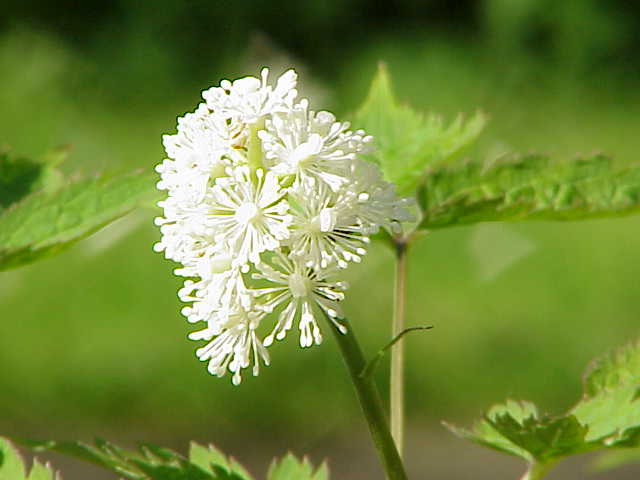- Actaea
image_width = 240px
image_caption = "Actaea rubra "
regnum =Plant ae
divisio = Magnoliophyta
classis =Magnoliopsida
ordo =Ranunculales
familia =Ranunculaceae
genus = "Actaea"
genus_authority = L.
subdivision_ranks = Species
subdivision = See text"Actaea" (baneberry or bugbane) is a
genus offlowering plant s belonging to the familyRanunculaceae , native to temperate regions of theNorthern Hemisphere .The genus is closely related to "
Cimicifuga " and "Souliea ", and many botanists include those genera within "Actaea" (e.g. Compton et al. 1998, Compton & Culham 2002, Gao et al. 2006, RHS Plant Finder, 2007) based on combined evidence from DNA sequence data, similarity in biochemical constituents and on morphology; if included, the number of species in "Actaea" rises to 25-30. Other botanists (e.g. Hoffman 1999, Wang et al. 1999, Lee & Park 2004) reject this merger because only one group (Actaea) have fleshy fruit while the remainder have dry fruit. The genus is treated here in its narrow sense, comprising four to eight species.;Selected species
*"Actaea asiatica "
*"Actaea pachypoda " - White Baneberry, White Cohosh, Doll's Eyes
*"Actaea rubra " (syn. "Actaea erythrocarpa") - Red Baneberry
*"Actaea spicata " (syn. "Actaea alba") - Baneberry, Herb ChristopherThe name "Actaea alba" (L.) Mill. is a confused one (Fernald 1940); although described as an American species (now named "A. pachypoda"), the illustration on which the description was based was actually a picture of the European "A. spicata", and strictly, the name is therefore a synonym of the European species. Some texts however still treat "A. pachypoda" under this name.
"Actaea" is recorded as a food plant for the
larva of theDot Moth .Use and toxicity
Baneberry contains cardiogenic toxins than can have an immediate sedative affect on human cardiac muscle tissue. The berries are the most poisonous part of the plant (hence the name baneberry). Ingestion of the berries can lead to cardiac arrest and death. The berries are harmless to birds, the plant's primary seed disperser. "Actaea" species are closely related to plants in the genus
Aconitum , a highly toxic plant genus which contains "wolfbane" and several varieties of "monkshood". [Edible and Medicinal Plants of the West, Gregory L. Tilford, ISBN 0-87842-359-1]The root of
Actaea rubra was used medicinally by Native Americans and has a long history of use as a strong alternative to Black Cohosh, ("Cimicifuga racemosa"), for menstrual cramping and menopausal discomfort. The roots of "Actaea rubra" contain β-sitosterolglucoside . [Planta Med 2006; 72: 1350-1352DOI: 10.1055/s-2006-951696] HIReferences
* Compton, J. A., Culham, A. & Jury, S. L. (1998). Reclassification of Actaea to include Cimicifuga and Souliea (Ranunculaceae): Phylogeny inferred from morphology, nrDNA ITS, and cpDNA trnL-F sequence variation. "Taxon" 47: 593–634.
* Compton, JA & Culham, A., 2002. Phylogeny and circumscription of tribe Actaeeae (Ranunculaceae). Syst. Bot., 27(3): 502-511
* Fernald, M. L. 1940. What is Actaea alba? "Rhodora" 42: 260-265.
* Gao, J-C., Zhang, J-C., Lu, Z-J, Zhu G-Y, Yang, M-S & Xiao, P-G, 2006. Chemical constituents of Actaea asiatica Hara and their anti-osteoporosis activities Biochemical Systematics and Ecology, 34(9): 710-713
* Hoffman, M. H. 1999. The phylogeny of Actaea (Ranunculaceae): a biogeographical approach. "Pl. Syst. Evol". 216: 251–263.
* Lee, H.-W. & Park, C.-W. (2004). New Taxa of Cimicifuga (Ranunculaceae) from Korea and the United States. "Novon" 14: 180–184 (available [http://www.fna.org/china/novon/novo-14-02-180.pdf online (pdf file)] .
* RHS Plant Finder http://www.rhs.org.uk/rhsplantfinder/plantfinder.asp
* Wang, W. T., Li, L.-Q. & Wang, Z. (1999). Notulae de Ran-unculaceis Sinensibus XXIII. "Acta Phytotax. Sin". 37: 209–219.
* [http://www.ars-grin.gov/cgi-bin/npgs/html/genus.pl?146 Germplasm Resources Information Network: "Actaea"] (treats genus in broad sense)
* [http://www.efloras.org/florataxon.aspx?flora_id=2&taxon_id=100421 Flora of China: "Actaea"] (treats genus in narrow sense)
* [http://www.efloras.org/florataxon.aspx?flora_id=1&taxon_id=100421 Flora of North America: "Actaea"] (treats genus in narrow sense)
* Edible and Medicinal plants of the West, Gregory L. Tilford, ISBN 0-87842-359-1
Wikimedia Foundation. 2010.

